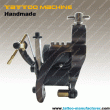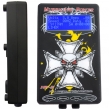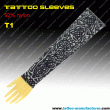Alana Lawton crouched over a young woman lying outstretched on a plastic, white fold-out table. A bright light focused on the woman’s bare midsection. A man, who was on the table just a few minutes ago, sat in the corner, watching.
Lawton, the proprietor of Arrows & Honor tattoo parlor in Glastonbury, Conn., wielded an electric needle across the woman’s skin. She focused. Her small hand moved swiftly. Her touch was light, almost airy.
Lawton seems misplaced in an industry dominated by rough-and-tumble men. Barely over 5 feet tall, with doe eyes and a bright smile, she looks like a pixie. She is not a woman who would beat a man in arm wrestling. But in the tattoo industry, where artists agree that a light touch outweighs a strong one, she may have a natural advantage.
“She’s definitely a lot more gentle than the guys are,” says tattoo-veteran Tina, a receptionist at a physical therapist’s office in New Milford, Conn.
Best tattoo practice emphasizes that light pressure should be applied to the needle so that only the top layers of skin are inked. If an artist pushes too hard and too deep into the skin, the ink will bleed, causing the lines to blur and the color to look blotchy.
“There is almost no cure for this and over time this ‘bleeding’ will naturally get worse,” Shaun Whalen, owner of Silk Liquid Tattoo in St. Catharines, Ontario, posted on BadTattoos.com.
A recent study published by the International Journal of Rehabilitation Research showed that the average woman exhibits only half the handgrip strength of the average man. A man will typically grip a tattoo needle with double the force of a woman.
“The two males that did my other ones actually went quite deep,” said Tina, who goes by a single name. “I had to have them covered up.”
Despite their potential advantage in the industry, not many women are picking up a tattoo needle. Statistics are scarce, but trade insiders estimate that there is fewer than 1 woman for every 6 male tattoo artists in America. Of the 250 artists that travel across the U.S. with the Body Art Expo , one of the largest tattoo trade shows in the world, less than 15 percent of the artists showcased are female.
Dr. Rachel Rhode, a surgeon at the Michigan Orthopaedic Institute who specializes in upper extremity surgery, speculated in an e-mail interview that proper tattoo techniques would have to do with control, rather than strength.
“I think these studies are more about how much force a hand could put on the object it is holding,” says Rhode, “not necessarily related to the force that can be generated by a hand using the object as a tool.” A male tattoo artist may hold a needle with a heavy hand but that doesn’t mean he can’t control how deeply he presses it into the skin.
“I’d consider a female but it’s more about the recommendation,” says a New York woman who had her husband’s initials tattooed shortly after their wedding in 2003 by a male artist. The 30-something account executive asked to remain anonymous for this story because “my dad doesn’t know.”
Most customers care more about feeling comfortable with the artist than how good they are with a needle.
“I didn’t put much thought into the artist,” said Lisa Held, a 24-year-old nonprofit worker from New York. “I liked that the place was clean, professional,” She had hummingbird tattooed on her forearm in 2008 in memory of her mother, and went to the same place in the East Village that she’s been going to “for years” for her piercing.
Anneli Kirotar, a 37-year-old Swede who works on cruise lines, went to a man named Ted. Kirotar said Ted was nice, but not the best artist. Yet, she returned three more times. “He was my work friend’s friend, he was cute and gave me good prices!”
Receptionist Tina swears by Arrows & Honor owner Lawton, strong hands or not. “I have six of them by her now and we’re gonna continue,” she said, “We just clicked.”
Lawton, whose parents are both artists, has noticed a difference between male and female artists. “If you look at paintings, I don’t know, I think a woman’s lines might be softer.” Lawton emphasized, however, that it has more to do with differences in artistry than gender.








